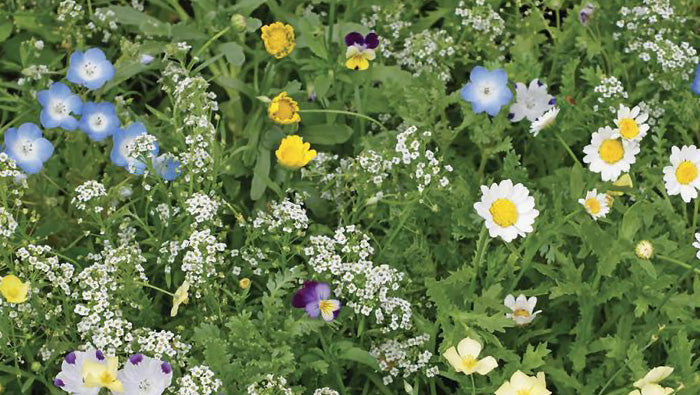
How to Grow Our Low Grow Flowering Pollinator Lawn
A little history about today’s lawns: The perfectly manicured green carpets that we still see in many neighborhoods only goes back a few decades. Back in 1960’s, many lawn mixes actually included clover. It wasn’t until 1962 when golf’s “Tournament Of Champions” appeared on the new color televisions that people wanted to have that perfect “look”. After years of turf grasses, that are heavily fertilized and often regularly sprayed with chemicals to manage the “weeds”, did we begin to understand that this practice could be detrimental to the health of pets, bees, birds, and other important pollinators. Today, many people have decided to turn back the calendar and return their lawns into a place friendly to pollinators and other living things.
Moving away from a turf grass lawn to a pollinator friendly wildflower lawn will take time, and there are a few different ways to approach the change over.
*The Quick Start Method:
If you want to totally eliminate your lawn from the start (or you are starting with bare ground), you’ll need to prepare the site by removing or killing all the existing grass or weeds. There are a few ways to achieve this:
• You can cover the grass with clear plastic and allow the sun to bake the grass and weeds (called solarizing), which takes a few weeks during the summer months. After the plants have died and are dry, remove the plastic, rake the dead material up and discard it.
• Another way is to use a non-selective herbicide over the area. These herbicides are designed to kill plants right to the roots. Be careful when applying these chemicals, and follow all label directions. After the plants have died, remove the dead material and discard it.
Once the area is cleared of all debris, use a metal rake to loosen up the top inch or so of the soil. Scarifying the soil will help increase the contact of the seed to the soil and improve germination. Scatter the seed according to recommended rates. Adding dry builder’s sand can make it easier to scatter the seed evenly. Avoid over-crowding; it can lead to poor growth. Press the seed lightly into the soil (no need to cover the seed completely) and water thoroughly. The newly planted seeds will need consistent moisture to germinate and to become established for the first 4-6 weeks. To help maintain the moisture in the area, you can cover the area with straw (not hay, it’s full of seeds) or a germination mat designed for new lawns.
*The Over Seeding Method:
If you don’t want to completely clear your lawn and you don’t mind the process taking a few years, you can continue to add our Low Grow Flowering Pollinator Mix to an existing lawn.
Start by mowing your existing lawn down as low as possible, right down to the soil if possible. Rake all the grass clippings up and discard them. Water the entire area very well 24 hours before you seed. Scatter the seed according to 1/2 the recommended rates and walk all over the area to press the seed into the soil as well as possible. Water the entire area again. Plan to continue overseeding for next 2-3 years; once in the very early spring, and again in the late fall.
The Follow-Up
*Persistence and Patience As with any garden or lawn, a pollinator lawn takes time to become established and flourish. Some varieties in our mix can take weeks to appear.
*Caring for your Low Grow Pollinator Lawn For the first few weeks, it’s crucial to maintain consistent moisture during the germination period and also during any prolonged dry weather for the first year. Our Low Grow Flowering Pollinator Lawn consists of varieties that don’t typically grow taller than 12”, and shouldn’t need to be mowed. If you need to mow for any reason, we recommend that it be done in the early fall, before pollinators start to look for places to hibernate.
*You’ll need to watch for invasive weeds and pull them out so they don’t take over your new pollinator lawn. Many wildflowers could be considered weeds, but it’s the truly invasive weeds that you’ll want to remove. The book “Weeds of The Northeast” is a great reference which helps identify weeds and wildflowers even in the seedling stage.>
*Often we are asked “When is the BEST time to plant a pollinator lawn”?
Normally this depends on your climate, rainfall & the varieties you choose. Unlike many wildflower mixes, the varieties in our Low Grow Flowering Pollinator Lawn do not need stratification and can be planted any time of the year, except the heat of the summer. Late fall is always the optimum time for the germination of the seed, but as long as the area is prepared as directed and kept moist until the plants are established, other times of the year will still produce good results.
